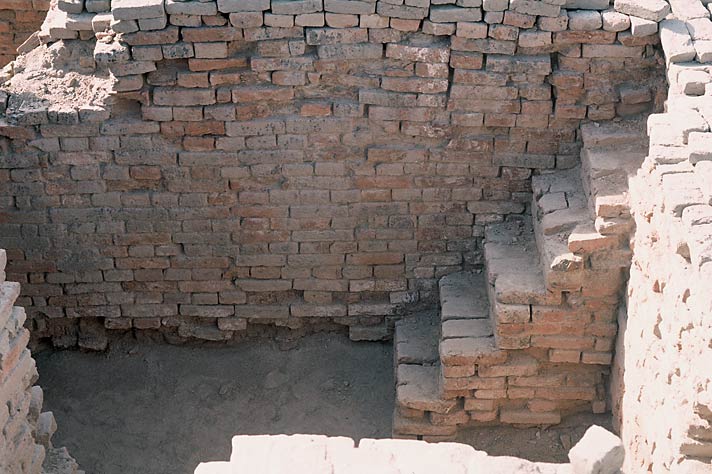
Staircases leading to a second story or to a platform for pouring water into a bathing area, Dikshit Area, Mohenjo-daro, excavated in the 1920s.
The Elamites are said to be Tamilians and so are the Indus Valley people. Were the people of common ethnic origin? Further the word Dravidians is supposed be derived from the word Tamilian? Is this true? Submitted by Anil. Editor’s note: In general, could you please explain the distinction between ethnicity and language and the extent to which they can be expected to overlap.
Iravatham Mahadevan
The Elamites lived thousands of years before and thousands of kilometres to the North of the earliest Tamil culture. Hence the two cannot be directly connected. As regards editor’s note above I would like to state with all the emphasis at my command that race and language are not inseparably connected. Speakers of one language can, and often did switch over from one language to another. In any case the rascial theories of 19th century have become obsolete with the discovery of genetic traits which show that all modern humans are descended from Africans less than a hundred thousand years ago.
Asko Parpola
Elamite is an extinct language attested in western Iran c. 2600-330 BCE. See M. W. Stolper in R. D. Woodard (ed.), World's ancient languages. Proto-Elamites created, on the basis of earlier Mesopotamian writing, their own undeciphered script in western Iran, and spread their culture, through a small number of powerful immigrants, far to eastern Iran (where the main population probably spoke non-Elamite languages) c 3100-2700 BCE. See D. T. Potts, The archaeology of Elam (1999). Early Harappans were in trade relations with the Proto-Elamites, and were to a limited extent influenced by them. The Indus people spoke an early Dravidian language, which was not Elamite, although David McAlpin (1981) has argued that Elamite is distantly related to the Dravidian languages (this hypothesis of "Proto-Elamo-Dravidian" has not been generally accepted).
From the Indo-Iranian borderlands and the Indus Valley, the Dravidian language family has spread both southwards and eastwards with Harappan-related archaeological cultures, including the Deccan Chalcolithic cultures, which gave rise to the Southern Neolithic culture around 2500 BCE. The language of the Southern Neolithic was probably Proto-South Dravidian, which in the course of time spread further south, one branch becoming Old Tamil attested since the last centuries BCE. Dravida or Dramida or Dramila occurs as a name of people in Sanskrit texts from around 400 BCE, and as Damila in Prakrit texts, and it is related to the word Tamil. In the 19th century, linguists adopted "Dravidian" as the family name of all languages related to Tamil.
During the four millennia that separate Tamil from its distant Proto-Dravidian linguistic ancestor, the language has changed considerably. The people speaking Tamil now are also likely to be largely of different genetic origin, for just like individual persons, entire peoples can start speaking another language. After the Romans conquered Gallia (France), the local Celtic speakers gradually adopted the Latin language of the conquerors, speaking it in their own way, the end result being modern French. Similarly, the spread of Dravidian languages has wiped out many unrelated languages spoken by the local populations, and this is likely to be the case with Tamil Nadu too.
